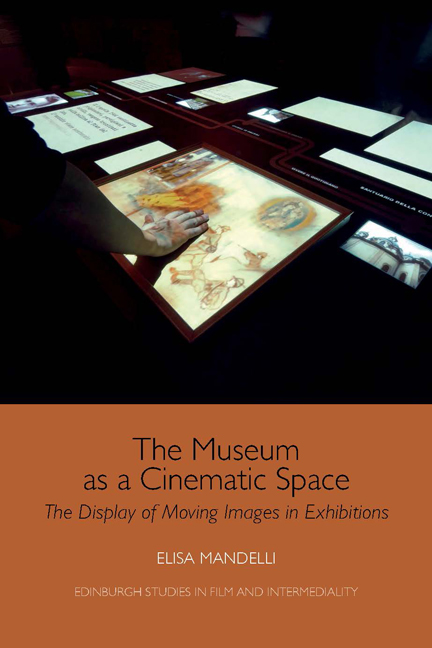Book contents
- Frontmatter
- Contents
- List of Figures
- Acknowledgements
- Preface
- Introduction
- Part I Between History and Modernity: Films in Exhibitions in the Twentieth Century
- 1 Cinema, Museums, Memory and Education
- 2 ‘A dimly-lighted corner’: Moving Images in Museums in the First Decades of the Twentieth Century
- 3 Moving Images in Museums, World's Fairs and Avant-garde Exhibition Design
- 4 The Multi-media Museum: The 1960s–70s
- Part II The Museum as a Cinematic Space: Museums and Moving Images in the Twenty-first Century
- Conclusions
- Bibliography
- Index
2 - ‘A dimly-lighted corner’: Moving Images in Museums in the First Decades of the Twentieth Century
from Part I - Between History and Modernity: Films in Exhibitions in the Twentieth Century
Published online by Cambridge University Press: 24 October 2019
- Frontmatter
- Contents
- List of Figures
- Acknowledgements
- Preface
- Introduction
- Part I Between History and Modernity: Films in Exhibitions in the Twentieth Century
- 1 Cinema, Museums, Memory and Education
- 2 ‘A dimly-lighted corner’: Moving Images in Museums in the First Decades of the Twentieth Century
- 3 Moving Images in Museums, World's Fairs and Avant-garde Exhibition Design
- 4 The Multi-media Museum: The 1960s–70s
- Part II The Museum as a Cinematic Space: Museums and Moving Images in the Twenty-first Century
- Conclusions
- Bibliography
- Index
Summary
MUSEUMS AND MOVIES: CINEMA AT THE IMPERIAL INSTITUTE
In April 1930, the British Museums Journal devoted a section to the theme ‘Museums and Movies’, publishing the transcripts of two lectures given at the museology conference in Worthing in July 1929: ‘The Panorama and the Cinema at the Imperial Institute’, by William T. Furse, and ‘The Cinema in Museums’, by Edwin E. Lowe. They address the relationship between musem and cinema from various angles and provide a kind of ‘state of the art’ of the use of film in museums during the 1920s and 1930s. The articles point to the idea that cinema was the ideal answer to a number of questions on the professional agenda of the time. According to the anonymous, enthusiastic author of the introduction, cinema was even more effective than dioramas, dramatic reconstructions, and even tableaux vivants in making museums more ‘lively’, due to its ability to bring ‘the whole life and movement of the world on to a few square feet in one little room’. The two essays that followed acknowledged the importance of moving images for the modernisation of museums, but presented two different points of view on how they should be used: in the exhibition galleries or in auditoriums.
The first article was signed by the director of the Imperial Institute, a research institute founded in 1887 as the National Memorial of Queen Victoria's Jubilee to promote the economic development of British colonies. The Imperial Institute's exhibition galleries featured items from all the British Empire, with the aim to show to the public its vastness, richness, and diversity. The institution was mentioned several times in the Museums Journal as a particularly successful example of balance between education and entertainment.
In accordance with the latest museological views, William Furse organised the galleries in order to avoid the cluttering of objects, and privileged the use of what he called ‘panoramas’ (also known as ‘dioramas’) to illustrate life scenes and industries from the various nations of the Empire. The Imperial Institute dioramas were three-dimensional models, half-way between painting and sculpture, mounted on a platform raised one metre above the floor and enclosed in a wooden structure with a glass panel on the front and a border of about twenty centimetres, electrically lit.
- Type
- Chapter
- Information
- The Museum as a Cinematic SpaceThe Display of Moving Images in Exhibitions, pp. 27 - 45Publisher: Edinburgh University PressPrint publication year: 2019



